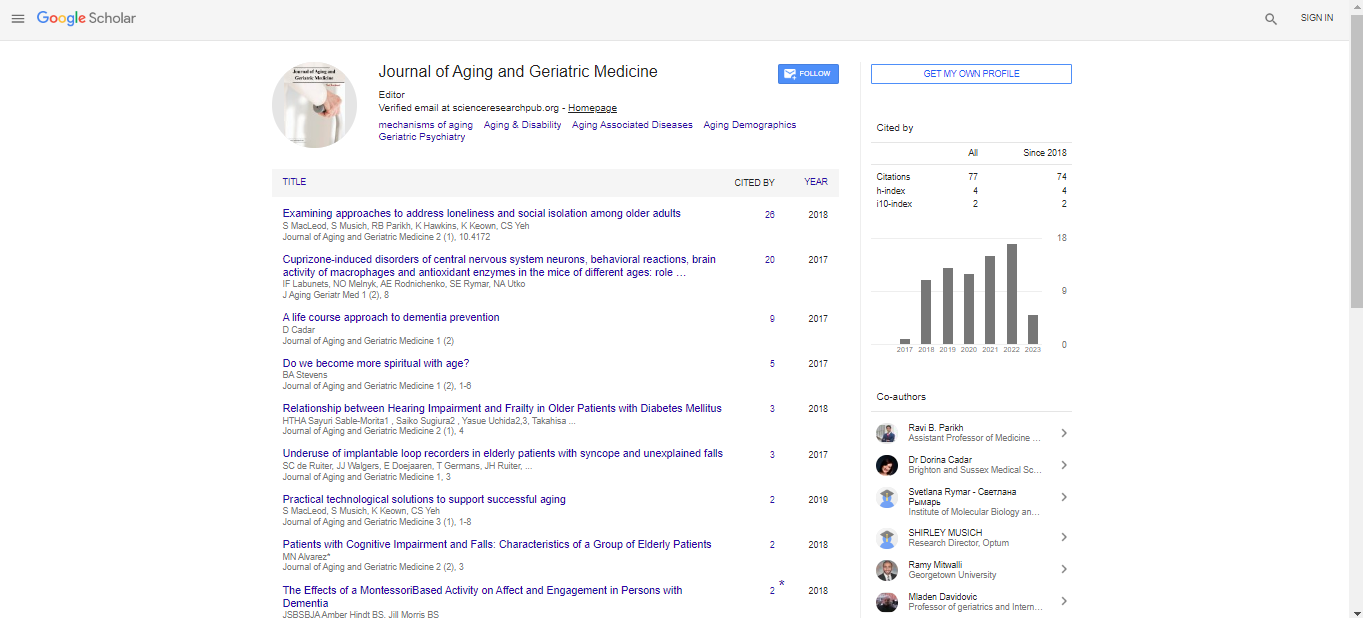Editorial, J Aging Geriatr Med Vol: 8 Issue: 2
Multimorbidity: A Complex Challenge in Modern Healthcare
Keiber Ossumana*
Department of Social Preventive Medical Sciences, German University in Cairo, Egypt
- *Corresponding Author:
- Keiber Ossumana
Department of Social Preventive Medical Sciences, German University in Cairo, Egypt
E-mail: keiber645@gmail.com
Received: 01-Jan-2025, Manuscript No. agm-25-169749; Editor assigned: 4-Jan-2025, Pre-QC No. agm-25-169749 (PQ); Reviewed: 18-Jan-2025, QC No. agm-25-169749; Revised: 25-Jan-2025, Manuscript No. agm-25-169749 (R); Published: 30-Jan-2025, DOI: 10.4172/2576-3946.1000183
Citation: Keiber O (2025) Multimorbidity: A Complex Challenge in Modern Healthcare. J Aging Geriatr Med 8: 183
Introduction
Multimorbidity—defined as the coexistence of two or more chronic conditions in an individual—is an increasingly common challenge in healthcare systems worldwide. As populations age and medical advances prolong life, more people are living longer with multiple health problems, such as diabetes, hypertension, heart disease, arthritis, depression, and chronic obstructive pulmonary disease (COPD). Unlike a single disease focus, multimorbidity requires a patient-centered, integrated approach to care, one that addresses the total burden of illness rather than treating each condition in isolation.
Managing multimorbidity is complex. It affects not only physical health but also psychological well-being, daily functioning, and overall quality of life. It places significant demands on patients, caregivers, and healthcare providers and contributes to increased healthcare costs, hospitalizations, and medication use [1], [2].
Multimorbidity refers to the presence of two or more chronic health conditions in an individual simultaneously. It is becoming increasingly common worldwide, particularly as populations age and people live longer with multiple long-term diseases. Unlike focusing on a single illness, multimorbidity presents a complex challenge because the conditions often interact and affect each other, requiring a more comprehensive approach to care [3], [4].
Common chronic diseases such as diabetes, hypertension, heart disease, arthritis, and depression frequently coexist, complicating diagnosis, treatment, and management. This complexity often leads to increased medication use (polypharmacy), higher healthcare costs, greater risk of adverse effects, and reduced quality of life for patients [5].
Multimorbidity affects physical health, mental well-being, and functional ability, making everyday tasks more difficult and increasing dependence on caregivers. Managing multiple chronic diseases simultaneously requires coordinated, patient-centered care that addresses the whole person rather than isolated conditions.
As healthcare systems worldwide face rising rates of multimorbidity, understanding its implications is crucial for developing effective strategies to improve outcomes and support individuals living with complex health needs.
Discussion
Multimorbidity refers to the coexistence of two or more chronic medical conditions within an individual. It is increasingly common, particularly among older adults, due to aging populations and advances in healthcare that allow people to live longer with chronic diseases. Unlike single-disease management, multimorbidity presents complex challenges for patients, healthcare providers, and healthcare systems.
The presence of multiple chronic conditions often leads to a higher burden of symptoms, increased healthcare utilization, and greater risk of adverse outcomes such as disability, hospitalization, and mortality. Common combinations include diabetes with hypertension, chronic obstructive pulmonary disease with heart disease, or arthritis with depression. These overlapping diseases often interact, complicating diagnosis, treatment, and disease progression.
One of the main challenges of managing multimorbidity is the potential for conflicting treatment recommendations. Clinical guidelines are typically disease-specific and do not always consider the interplay of multiple conditions. As a result, patients may be prescribed numerous medications, increasing the risk of polypharmacy, drug interactions, and side effects. This complexity can lead to decreased adherence to treatment plans and poorer health outcomes.
Furthermore, multimorbidity impacts patients’ quality of life and functional status, making it difficult to maintain independence and engage in everyday activities. The psychological burden is also significant, as living with multiple chronic illnesses can cause anxiety, depression, and social isolation.
Effective management of multimorbidity requires a patient-centered, holistic approach. This includes comprehensive assessments that consider the full range of medical, psychological, and social factors affecting the patient. Shared decision-making is crucial to align treatment goals with patients’ preferences and priorities, often emphasizing quality of life over disease-specific targets.
Integrated care models involving multidisciplinary teams have shown promise in addressing the complex needs of patients with multimorbidity. These teams coordinate care across specialties, reduce fragmentation, and provide support for self-management.
In conclusion, multimorbidity represents a significant challenge in modern healthcare, requiring a shift from disease-focused care to individualized, coordinated approaches. Addressing this complexity is essential to improving outcomes and quality of life for the growing number of individuals living with multiple chronic conditions.
Conclusion
Multimorbidity is one of the defining healthcare challenges of the 21st century. It demands a shift from disease-focused care to a holistic, patient-centered model that considers the entire spectrum of an individual’s health needs. Successful management requires coordination across disciplines, personalized care plans, effective use of resources, and active engagement of patients in their care. As we face an aging population and increasing rates of chronic disease, recognizing and effectively managing multimorbidity is essential to improving health outcomes, preserving quality of life, and ensuring the sustainability of healthcare systems worldwide. Furthermore, health systems must adapt to better support individuals with multimorbidity by prioritizing continuity of care and accessible resources. Early identification and proactive management can prevent complications, reduce hospitalizations, and improve outcomes. In summary, multimorbidity demands a thoughtful, coordinated approach that goes beyond managing isolated diseases. By focusing on the whole person rather than individual conditions, healthcare providers can enhance quality of life and functional independence for the growing population living with multiple chronic illnesses.
References
- Branson R. D (2013). Asynchrony and Dyspnea. Respiratory Care. 58:973â??989.
- Van Kaam, Anton (2011) Lung-Protective Ventilation in Neonatology. Neonatology 99:338â??341. Howard Stein, Kimberly Firestone, BS, Peter C, Rimensberger (2018) Synchronized Mechanical Ventilation Using Electrical Activity of the Diaphragm in Neonates.
- Mallik M, Watson AR (2008) Antenatally detected urinary tract abnormalities more detection but less action. Pediatr Nephrol. 23: 897-904.
- Woodward M, Frank D (2002) Postnatal management of antenatal hydronephrosis. BJU Int 89: 149-156.
 Spanish
Spanish  Chinese
Chinese  Russian
Russian  German
German  French
French  Japanese
Japanese  Portuguese
Portuguese  Hindi
Hindi 